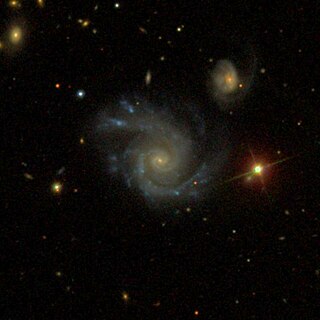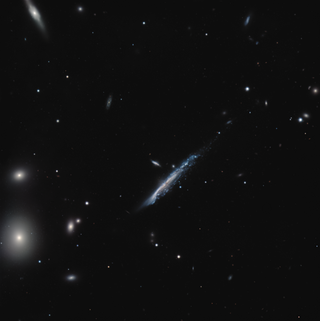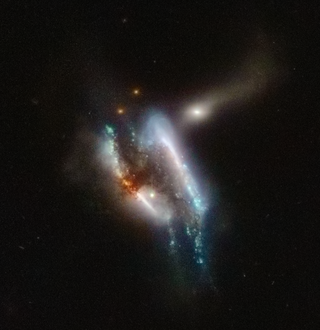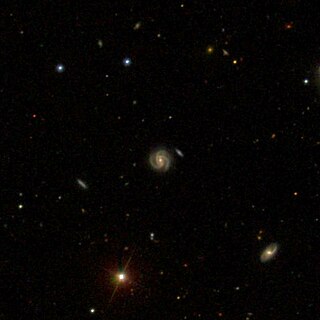
NGC 5829 is a spiral galaxy located in the constellation Boötes. It is 281 million light-years away from Earth and was discovered by astronomer, Edouard Stephan in May 1882.

NGC 5533 is an unbarred spiral galaxy in the constellation Boötes. It was discovered by the astronomer William Herschel on May 1, 1785. It has a regular structure, with one tightly wound spiral; its disk is inclined about 53 degrees towards the line of sight.

NGC 4868 is an unbarred spiral galaxy located about 240 million light-years away in the constellation Canes Venatici. It was discovered by William Herschel on March 17, 1787. A 2002 study suggests that a quasar may exist within NGC 4868.

IC 4271 is a spiral galaxy located some 800 million light-years away in the Canes Venatici constellation. It is 130,000 light-years in diameter. IC 4271 was first located on July 10, 1896, by Stephane Javelle, a French astronomer. It hosts a Seyfert type 2 nucleus, containing an acceleration disc around its supermassive black hole which releases large amounts of radiation, hence its bright appearance. IC 4271 appears to be interacting with its smaller neighboring galaxy, PGC 3096774.

IC 4462 is an elliptical galaxy located in the Boötes constellation. It is located 417 million light-years away from the Solar System and was found by Stephane Javelle on June 22, 1895 the same day he discovered IC 4461, a spiral galaxy. It is gravitationally interacting with IC 4461 and possibly might merge with the latter in the future. Both galaxies form Arp 95, which they are classified under galaxies that have elliptical companions. Sometimes the galaxy is confused with IC 4461.

IRAS 14348-1447 known as PGC 52270, are a pair of spiral galaxies located 1 billion light-years away in the constellation of Libra. The galaxy IRAS 14348-1447NE, is in the early process of merging with IRAS 14348-1447SW, causing gravity to pull stars from both galaxies and forming tidal tails. As the interaction takes place, molecular gas is swirled about and creating emission that is responsible for the galaxies' ultraluminous appearance.

UGC 6697 is a large irregular spiral galaxy with a bar located in the Leo constellation. It is located 378 million light-years from the Solar System and has an estimated diameter of 205,000 light-years. UGC 6697 is considered a starburst galaxy which produces high rates of star formation. The first known reference to this galaxy comes from volume II of the Catalogue of Galaxies and of Clusters of Galaxies compiled by Fritz Zwicky in 1968, where it was listed as CGCG 097-087, and its coordinates listed as 1141.2 + 2015.

IC 4040 is a type SABc spiral galaxy with a bar in Coma Berenices. It is located 353 million light-years away from the Solar System and has an estimated diameter of 105,000 light-years making it slightly larger than the Milky Way. IC 4040 was discovered on April 12, 1891, by Guillaume Bigourdan and is a member of the Coma Cluster.

IC 535 known as PGC 26524 and PGC 1128295, is a type E elliptical galaxy with a ring located in the Hydra constellation. It is located 740 million light-years away from the Solar System and has an estimated diameter of 85,000 light-years. IC 535 was discovered on March 23, 1893, by Stephane Javelle. It has a surface brightness of 23.7 mag/arcsec and is moving at radial velocity of 16,049 kilometers per seconds. It is located at right ascension and declination.

IC 2431 are a group of interacting galaxies in the constellation of Cancer. They are located 684 million light-years away from the Solar System and were discovered on February 24, 1896, by Stephane Javelle.

IC 1166 are a pair of galaxies in the Corona Borealis constellation comprising IC 1166 NED01 and IC 1166 NED02. They are located 977 million light-years from the Solar System and were discovered on July 28, 1892, by Stephane Javelle.

IC 1182 is a type S0-a lenticular galaxy located in Hercules. It is located 464 million light-years away from the Solar System and was discovered on August 11, 1892, by Stephane Javelle. IC 1198 is a member of the Hercules Cluster, which is a part of the CfA 2 Great Wall.

NGC 3753 is a large spiral galaxy with a bar located in the Leo constellation. It is located 435 million light-years away from the Solar System and was discovered on February 9, 1874, by Ralph Copeland.

NGC 3748 is a lenticular galaxy with a bar located in the Leo constellation. It is located 440 million light-years away from the Solar System and was discovered by Ralph Copeland on April 5, 1874, but also observed by Hermann Kobold, Lawrence Parsons and John Louis Emil Dreyer.

NGC 3754 is a small barred spiral galaxy located in Leo. It is located 447 million light-years away from the Solar System and was discovered on April 5, 1874, by Ralph Copeland.

NGC 3751 is a type E-S0 lenticular galaxy located in the Leo constellation. It is located 450 million light-years away from the Solar System and was discovered by Ralph Copeland on April 5, 1874.

Arp 60 also known as LEDA 1762846, is a barred spiral galaxy located in Coma Berenices. It is located 958 million light-years from the Solar System and has an approximate diameter of 95,000 light-years.

IC 2498 known as PGC 27668, is a type Sb barred spiral galaxy located in constellation Leo. It is located 469 million light-years away from the Solar System and was discovered by Stephane Javelle on April 30, 1896.

IC 4539 is a type SABb intermediate spiral galaxy located in Corona Borealis. Its redshift is 0.061307, which corresponds IC 4539 to be 845 million light-years from Earth. It has an apparent dimension of 0.40 x 0.4 arcmin, meaning the galaxy is about 95,000 light-years across. IC 4539 was discovered by Stephane Javelle on June 23, 1903, who found it "as faint, small, round with a very brighter middle."

IC 1327 is lenticular galaxy of type S0-a, located in the constellation Aquila. Its redshift is 0.032386, which corresponds IC 1327 to be located 445 million light-years from Earth. It has an apparent dimension of 0.90 x 0.8 arcmin, meaning the galaxy is 117,000 light-years across. IC 1327 was discovered on August 10, 1890, by Sherburne Wesley Burnham.

















